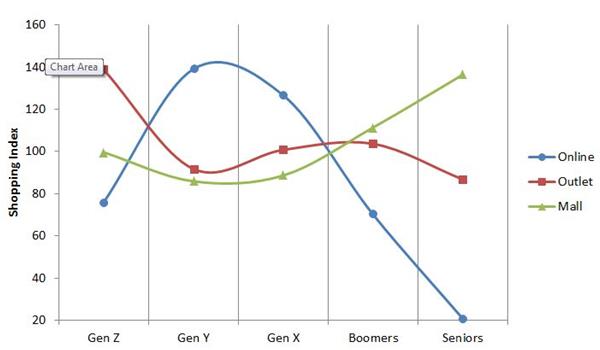
Checkout: How the Generations Prefer to Shop
As members of the Environics Analytics practice team that serves retail and real estate clients, we get a first-hand peek into emerging trends in the industry. At this time, we’ve observed two developments that retail and real estate professionals are talking about: generational shopping patterns and multi-channel marketing. You can’t go to a conference or read an industry publication without finding reference to at least one of these crazes and how it’s the most important factor influencing business today. So we decided to use the vast pool of data available at our fingertips to comment on these evolving trends.
Of course, everyone has their own opinion on which is the best generation to target or whether online shoppers are different than brick-and-mortar shoppers. But we have data that can put these arguments to rest—or at least offer some insight for a fact-based opinion. Using national survey data from Numeris (formerly BBM RTS Canada), we evaluated shopping trends within three channels: online, discount outlets and shopping malls through the lens of five generations: Gen Z, Gen Y, Gen X, Boomers and Seniors. The following line diagram displays the shopping index based on heavy shopping behavior (compared to the average Canadian consumer) for each channel across the five generations.

Source: Numeris (formerly BBM RTS Canada) 2014
We can imagine each of the lines above taking a journey through the generations with highs and lows depending on whether or not each cohort has a tendency to shop a channel. For instance, we see that a lower proportion of online shoppers come from the youngest generation, Gen Z. At first glance, this might conflict with how we perceive people under 20, who seem to take every opportunity to go online or “be connected”. However, just because they are online, does not necessarily mean that they are shopping online. The Internet is a playground for this generation with social media and online gaming. And with new ways to learn and have fun getting released every day, who has time to shop? Furthermore, when we consider the ages of this generation—under 20 years old—most are not old enough to apply for a credit card, and many lack part-time jobs or disposable income to spend freely. They may still rely on their parents’ wallets, so shopping trips with the folks to malls and outlets are how they get their clothes or entertainment fix. Also, to the dismay of some adults, teenagers tend to spend a lot of time hanging out at malls with friends. So they frequently make purchases there—while taking a breather between scarfing down Doritos Locos Tacos. A marketer targeting this young group for online shopping may be missing their mark.
By contrast, the sought-after Millennials of Gen Y and the rebellious Gen X are extremely heavy online shoppers. They buy everything from clothing to home improvement products over the Internet. This trend may be indicative of their busy lifestyles. Gen Y is at a transitional lifestage—between 20 and 40 years old—when many are graduating post-secondary school, starting careers, launching families, buying their first home– and the list of firsts goes on. They typically do not have the time to visit malls and shop outlets for the hottest styles and best deals, but they still want many brand options and the ability to check out new and unique retail choices. Shopping online provides extensive product information, easy access to limitless options and delivery to the front door—a channel preference that is growing in popularity.
Members of Gen X are also heavy online shoppers, but even they are experiencing a slight shift back into brick-and-mortar channels. In particular, an increasing number are shopping outlets at heavy rates. Many have teenage kids and own homes, and they’ve learned the value of trying to save money during a period of their lives when they’re also increasing their debt load. Shopping fashionable styles is still important to this group, but their interests are somewhat depressed by their cash-strapped status compared to their Millennial brothers and sisters. Many are moving away from the ZARAs and H&Ms of the world and moving towards practical clothing retailers like Mark’s Work Wearhouse.
Boomers and Seniors are the least likely generations to shop online as they show greater interest in malls at these lifestages. This pattern is due to a shift towards one-stop shopping. Boomers have a large amount of wealth but they’re less concerned with spending time online conducting product research, particularly for the trendiest fashions. They prefer to rely on the opinions of the merchandise buyer for department stores such as The Bay and Sears who put forth good value clothing from contemporary brands. Also, many members of this generation prefer simply to touch products and try on clothes before they buy them.
Seniors are the generation that did not have the opportunity or the willingness to adopt computers and the Internet. And while your grandmother may have Facebook and Angry Birds on her iPad, she certainly does not feel as comfortable shopping online as younger generations. For seniors, an even stronger movement into department store shopping occurs as the one-stop shopping trend becomes stronger and, of course, we can’t forget the shopping centre regulars, the “mall-walkers” who window-shop while getting their weekly exercise. (We say “good for them” for staying active; they probably get out a little more often than some of the geeks we know.)
So please cite our data when the conversation turns to shopping at your next party. But remember that the multi-channel retail environment is a dynamic and continuously evolving conundrum. Our fellow colleagues, customers and academics will continue to produce new insights and opinions as people’s shopping behaviour evolves. And while there is no one right answer for a multi-channel retail approach, there is one wrong answer: inaction.
—Vito De Filippis and Mark Lebovits

